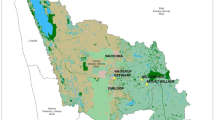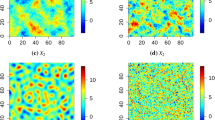Abstract
Top-kriging is a method for estimating stream flow and stream flow-related variables on a river network. Top-kriging treats these variables as emerging from a two-dimensional spatially continuous process in the landscape. The top-kriging weights are estimated by a family of variogram models (regularisations) for different catchment areas (kriging support), which accounts for the different scales and the nested nature of the catchments. This assures that kriging weights are distributed to both hydrologically connected and unconnected sites of the stream network according to the data situation: top-kriging gives most weight to close-by sites at the same river system, but when the next hydrologically connected site is far away, more weight is given to a close-by site at an adjacent river system. The distribution of weights is in contrast to ordinary kriging and stream distance-based kriging which does not account for both spatial proximity and network connectivity. We extend the top-kriging method by incorporating an external drift function to account for the deterministic patterns of the spatial variable. We test the method for a comprehensive Austrian stream temperature dataset. The drift is modelled by exponential regression with catchment altitude. Top-kriging is then applied to the regression residuals. The variogram used in top-kriging is fitted by a semiautomatic optimisation procedure. A leave-one-out cross-validation analysis shows that the model performs well for the study domain. The residual mean squared error (cross-validation) decreases by 20 % when using top-kriging in addition to the regression model. For regions where the observed stream temperatures deviate from the expected value of the drift model, top-kriging corrects these regional biases. By exploiting the topological information of the stream network, top-kriging is able to improve the local adjustment of the drift model for the main streams and the tributaries.












Similar content being viewed by others
References
Benyahya, L., Caissie, D., St-Hilaire, A., Ouarda, T. B. M. J., & Bobee, B. (2007). A review of statistical water temperature models. Canadian Water Resources Journal, 31, 179–192.
Blöschl, G., & Sivapalan, M. (1995). Scale issues in hydrological modelling—a review. Hydrological Processes, 9, 251–290.
Caissie, D. (2006). The thermal regime of rivers: a review. Freshwater Biology, 51(8), 1389–1406.
Cressie, N. (1985). Fitting variogram models by weighted least squares. Mathematical Geology, 17, 563–586.
Cressie, N. (1991). Statistics for spatial data. New York, NY: Wiley.
Cressie, N., Frey, J., Harch, B., & Smith, M. (2006). Spatial prediction on a river network. Journal of Agricultural, Biological, and Environmental Statistics, 11, 127–150.
de Marsily, G. (1986). Quantitative hydrogeology. London: Academic.
Gardner, B., Sullivan, P. J., & Lembo, A. J., Jr. (2003). Predicting stream temperatures: geostatistical model comparison using alternative distance metrics. Canadian Journal of Fisheries and Aquatic Sciences, 60, 344–351.
Garreta, V., Monestiez, P., & Ver Hoef, J. M. (2010). Spatial modelling and prediction on river networks: up model, down model or hybrid? Environmetrics, 21, 439–456. doi:10.1002/env.995.
Godina, R., Nobilis, F., Webb, B.W. (2005). Wassertemperaturen [Water temperature]. Karte 5.6. In Bundesministerium für Land-und Forstwirtschaft, Umwelt und Wasserwirtschaft (Ed.), Hydrological Atlas Austria. Österreichischer Kunst-und Kulturverlag Wien. ISBN 3-85437-250-7.
Gottschalk, L. (1993). Correlation and covariance of runoff. Stochastic Hydrology and Hydraulics, 7, 85–101.
Gottschalk, L. (1993). Interpolation of runoff applying objective methods. Stochastic Hydrology and Hydraulics, 7, 269–281.
Gottschalk, L., Krasovskaia, I., Leblois, E., & Sauquet, E. (2006). Mapping mean and variance of runoff in a river basin. Hydrology and Earth System Sciences, 10, 469–484.
Gotway, C. A., & Young, L. J. (2002). Combining incompatible spatial data. Journal of the American Statistical Association, 97, 632–648.
Isaaks, E. H., & Srivastava, R. M. (1989). An introduction to applied geostatistics. New York, NY: Oxford University Press.
Kyriakidis, P. C. (2004). A geostatistical framework for area-to-point spatial interpolation. Geographical Analysis, 36, 259–289.
Laaha, G., & Blöschl, G. (2006). Seasonality indices for regionalizing low flows. Hydrological Processes, 20, 3851–3878.
Laaha, G., & Blöschl, G. (2006). A comparison of low flow regionalisation methods—catchment grouping. Journal of Hydrology, 323(1/4), 193–214.
Laaha, G., & Blöschl, G. (2007). A national low flow estimation procedure for Austria. Hydrological Sciences Journal, 52(4), 625–644.
Laaha, G., Skøien, J., Blöschl, G. (2013). Spatial prediction on river networks: comparison of top-kriging with regional regression. Hydrological Processes. doi:10.1002/hyp.9578.
Matheron, G. (1965). Les variables regionalisées et leur estimation. Paris, France: Masson.
Mockus, A. (1998). Estimating dependencies from spatial averages. Journal of Computational and Graphical Statistics, 7, 501–513.
Peterson, E. E., Theobald, D. M., & Ver Hoef, J. M. (2007). Geostatistical modelling on stream networks: developing valid covariance matrices based on hydrologic distance and stream flow. Freshwater Biology, 52, 267–279.
Peterson, E. E., & Ver Hoef, J. M. (2010). A mixed-model moving-average approach to geostatistical modelling in stream networks. Ecology, 91(3), 644–651.
Sauquet, E., Gottschalk, L., & Leblois, E. (2000). Mapping average annual runoff: a hierarchical approach applying a stochastic interpolation scheme. Hydrological Sciences Journal, 45, 799–815.
Skøien, J. O., & Blöschl, G. (2006). Sampling scale effects in random fields and implications for environmental monitoring. Environmental Monitoring and Assessment, 114(1–3), 521–552.
Skøien, J. O., Blöschl, G., & Western, A. W. (2003). Characteristic space–time scales in hydrology. Water Resources Research, 39, 1304–1323.
Skøien, J. O., Merz, R., & Blöschl, G. (2006). Top-kriging—geostatistics on stream networks. Hydrology and Earth System Sciences, 10, 277–287.
Ver Hoef, J. M., Peterson, E., & Theobald, D. (2006). Spatial statistical models that use flow and stream distance. Environmental and Ecological Statistics, 13, 449–464.
Wackernagel, H. (1995). Multivariate geostatistics. Berlin: Springer.
Webb, B. W., Hannah, D. M., Moore, R. D., Brown, L. E., & Nobilis, F. (2008). Recent advances in stream and river temperature research. Hydrological Processes, 22(7), 902–918.
Wehrly, K. E., Brenden, T. O., & Wang, L. (2009). A comparison of statistical approaches for predicting stream temperatures across heterogeneous landscapes. Journal of the American Water Resources Association, 45(4), 986–997.
Acknowledgments
Top-kriging was performed using the original FORTRAN code of [26] and the R package “Rtop” which can be freely downloaded from R-Forge platform at http://R-Forge.R-project.org. The authors would like to thank the Austrian Science Foundation (FWF, project no. P18993-N10), the Austrian Academy of Sciences “Hydrological Predictability” Project and the Austrian Climate Research Program “CILFAD” Project for financial support. Many thanks to Franz Suppan (Institute of Surveying, Remote Sensing and Land Information, University BOKU Vienna) for providing specific GIS functionality for catchment aggregation and to two anonymous reviewers for their valuable comments on the manuscript.
Author information
Authors and Affiliations
Corresponding author
Rights and permissions
About this article
Cite this article
Laaha, G., Skøien, J.O., Nobilis, F. et al. Spatial Prediction of Stream Temperatures Using Top-Kriging with an External Drift. Environ Model Assess 18, 671–683 (2013). https://doi.org/10.1007/s10666-013-9373-3
Received:
Accepted:
Published:
Issue Date:
DOI: https://doi.org/10.1007/s10666-013-9373-3




